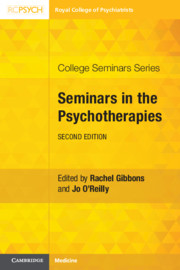Book contents
- Seminars in the Psychotherapies
- College Seminars Series
- Seminars in the Psychotherapies
- Copyright page
- Reviews
- Contents
- Contributors
- Foreword
- Preface
- Part I Therapy Theory and Practice
- Part II Applied Psychotherapeutic Thinking
- Section 1 Psychological and Psychodynamic Approaches to Psychiatry
- Section 2 Work in Practice
- Chapter 21 The Effect on Staff and Organisations of Working with Patients with Psychotic Illness
- Chapter 22 Introduction to Organisational Dynamics
- Chapter 23 Reflective Practice and Its Central Place in Mental Health Care
- Chapter 24 Working Psychotherapeutically with Children
- Chapter 25 Therapeutic Communities
- Section 3 Contemporary Developments
- Index
- References
Chapter 24 - Working Psychotherapeutically with Children
from Section 2 - Work in Practice
Published online by Cambridge University Press: 27 May 2021
- Seminars in the Psychotherapies
- College Seminars Series
- Seminars in the Psychotherapies
- Copyright page
- Reviews
- Contents
- Contributors
- Foreword
- Preface
- Part I Therapy Theory and Practice
- Part II Applied Psychotherapeutic Thinking
- Section 1 Psychological and Psychodynamic Approaches to Psychiatry
- Section 2 Work in Practice
- Chapter 21 The Effect on Staff and Organisations of Working with Patients with Psychotic Illness
- Chapter 22 Introduction to Organisational Dynamics
- Chapter 23 Reflective Practice and Its Central Place in Mental Health Care
- Chapter 24 Working Psychotherapeutically with Children
- Chapter 25 Therapeutic Communities
- Section 3 Contemporary Developments
- Index
- References
Summary
The essential goals of the child and adolescent psychotherapist are not dissimilar to those of the adult therapist: to understand and render meaningful troubled aspects of the personality. The process brings insight to bear on the nature of the internal world and its mixed population of figures, benign and persecutory. Mental development occurs not so much through ‘ironing out’ the difficulties, but rather through ‘an increase in the capacity to bear reality and a decrease in the obstructive force of illusions’ [1, p. 51]. Bearing reality lies in being able to reintegrate aspects of the personality that have been disowned, or disavowed as too threatening to psychic equilibrium. The process of integration involves taking back projections and bearing the discomfort of being brought into relation with the less manageable aspects of the self. The method is based on the observation and interpretation of the transference and countertransference relationship, the elucidation of dreams and, in the case of children and adolescents, the underlying meaning of play and enactments of whatever kind that take place both in and outside the consulting room.
- Type
- Chapter
- Information
- Seminars in the Psychotherapies , pp. 312 - 322Publisher: Cambridge University PressPrint publication year: 2021



